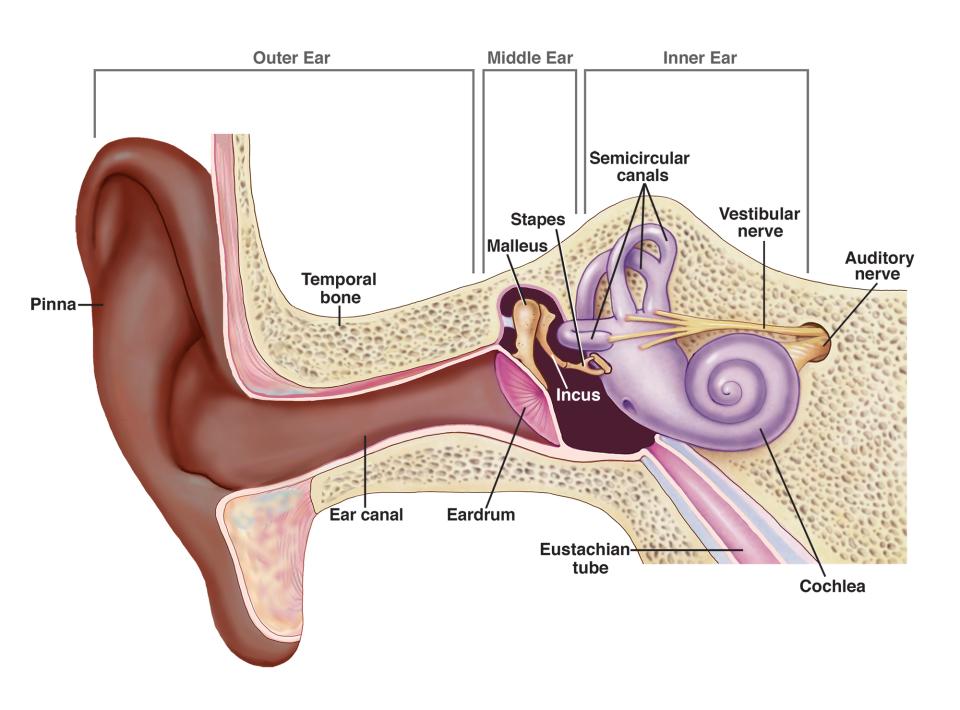“Age is an issue of mind over matter. If you don’t mind, it doesn’t matter.” – Mark Twain.
In the last year or so, specifically since taking up Jiu Jitsu, I have noticed a change in my equilibrium, not that I am having trouble maintaining balance. Still, when I do break rolls (forward or back), once I stop, it takes a little bit for my sense of balance to catch. The body stops rolling, but the head still feels like it is. This feeling stops within a few seconds, but it isn’t reassuring. I can still happily do cartwheels down the training hall. There is no ‘physical’ issue. I just need to stop for a few seconds afterwards to let my head settle back into place.
As to why that happens, well, it’s all a part of the grand ballet of life, friends. Have you ever witnessed a dog shaking itself wildly after coming out of water? Strangely enough, this is similar to what our inner ears do when they experience a sudden change in velocity or position.
Let me paint you an illustrative picture. Picture the cups and tubes inside our ears as a dazzling, intricate network of water slides at a theme park. When we perform actions like a head-tilting forward roll or a dizzying helicopter spin on the dance floor, we essentially send our “inner ear bathers”, the collection of sensory cells and fluids, rushing through these slides. Once we stop, the bathers are still zooming and splashing about, processing the tail end of the fun-filled ride. Like a rubber duck bobbing in a whirlpool, everything takes a few moments to still after the action ceases. In real life, that’s your sense of balance playing catch up, catching its metaphorical breath, if you will, before addressing the world once more.
The bummer here is that the water park gets a bit of a battering as we age. The exuberance of youth fades, the slides get a bit rusty, the bathers get a tad sluggish. The fancy way to put it? Age-related changes to our inner ears dull the razor-sharp reaction times we enjoyed during our sprightly years. These changes can result in the occasional somewhat disorienting feeling of ‘head spins’ as the poor old noggin struggles to compute the sudden transition. After all, it’s only trying to keep up with the ever-enthusiastic pace our bodies insist on maintaining.
Balance and Equilibrium as a measure of ‘quality of life’
I believe Peter Attica talks about the ability to stand on one foot and put on your shoes as a good measure of your ability to balance, not fall over, and, if you do, get back up. In older people, it becomes a genuine concern if you lose the ability to safely shift levels from standing to sitting, to crouching, lying, etc. Being aware of and maintaining our sense of balance becomes increasingly important as a measure of not only our ‘health’, but our quality of life and level of independence in the world. While I am a long way off from being unable to get myself off the floor (technical stand-ups are still going well in training!) I can see the long-term path there.

The Inner Ear – A Mini Anatomy Lesson
Before diving into our journey of maintaining equilibrium, let’s have a mini anatomy lesson. Our inner ear, the vestibular labyrinth to be exact – and yes, it’s as twisty as it sounds – comprises three semi-circular canals and two otolith organs.
- Semi-circular canals are the three fluid-filled tubes, each responsible for detecting different types of head movements.
- Otolith organs (the utricle and the saccule): These two lads monitor the position of your head relative to gravity and dynamic linear movements, such as in a car or on a rollercoaster.

So, when these elements work harmoniously, they create a symphony of stability. Yet, quite like a punk rocker crashing a string quartet mid-performance, the balance of this harmony can sway with age, affecting our dear friend balance along the way.
The Ageing Process: How it Affects the Inner Ear
So, we’ve skimmed the surface of the inner ear’s complexity, but the plot thickens as we grow older. It’s almost as if the inner ear declares, “Ageing? Now, that’s my cue to stir the pot!”
As we age, the cells within our inner ear — mainly the hair cells, begin to feel the weight of time. These cells, which act like little conductors leading the symphony of signals to our brain, slowly lose their stamina and vitality. When these diligent workers start to ‘retire’, equilibrium can become as challenging as a drunken flamingo on roller skates. That’s where the trouble begins.

Tales from the Vestibular System
Picture it: your once robust vestibular system entering a mid-life crisis. The ability to maintain balance, generally taken for granted, suddenly becomes a precarious task. Why? You may ask. It’s mainly due to the gradual degeneration of those oh-so-crucial hair cells and some other fun tweaks within your vestibular system — the part of the inner ear responsible for balance.
Think of it like this: Your once high-performance, equilibrium-maintaining system is now more of a clunky, old pickup truck’s suspension — struggling with bumps and sudden manoeuvres. But don’t fret; we’re all aboard the same shaky boat!
The Link Between Inner Ear Changes and Balance
Our topic of discussion might seem as obscured as a cave bat’s sense of colour, but take it from me; it’s no less important. You see, the inner ear, that compact labyrinth housing your auditory and balance apparatus, gets a bit — how do I put it delicately — forgetful as we age. Like that old, half-deflated tennis ball you’ve meant to replace, it simply doesn’t bounce back like it used to.
There’s a unique and intricate relationship between changes in your inner ear and your ability to balance. This is akin to a wobbly table in a rickety old pub; fine while you’re observing, but the moment you compel it to function, you’ve got yourself a tipsy disaster.
Dissecting the Dance: Inner Ear Changes and Equilibrium
The marvellously made-up term for this delicate spin cycle of balance is ‘vestibular compensation’. Your brain and inner ear execute this dance flawlessly, but when your inner ear starts to lose its pep, your sense of balance takes a nosedive. Think of it as a relay race. The inner ear passes the baton of information to the brain, and a healthy stride is maintained. If that baton is a tad slippery (or, in this case, the messages become compromised), our runner stumbles and the race goes pear-shaped.
Facing the Music: Inner Ear and Balance Disorders
Our dear maturing bodies can give rise to all manner of pickles, chief among them being inner ear disorders. Vertigo, tinnitus, and Meniere’s disease are not precisely a roll-off-the-tongue party list and are as pleasant as stepping barefoot on a LEGO brick. Bear with me as I bring you into the loop in an impossibly witty and less scientific fashion.
- Vertigo: This is more than just a fantastic Hitchcock movie. Vertigo is a dizzying disorder that could make you feel like you’ve sipped one too many at happy hour when, in fact, you’re sober as a judge.
- Tinnitus is the immoveable squatter in your inner ear, producing a constant ringing sound. I wish you could, but I’m afraid you can’t evict this one with a strongly worded letter.
- Meniere’s Disease: This is an unpleasant guest that brings along hearing loss, tinnitus (yes, that rascal from above), and a fiesta of vertigo. Remember that it’s not nice to have an unwanted guest show up with friends.
One can adopt preventive measures to lessen the impact of these changes. However, it all hinges upon understanding what’s going on with our balance system. In the upcoming sections, we’ll delve into the means at our disposal for early detection and prevention, and, without a doubt, I’ll have plenty more metaphors to share. Buckle up, folks!
Taking Control: Preventive Measures for Inner Ear Changes
Now that we’ve tiptoed our way around the noisy tavern that is the inner ear let’s make a swift segue into how we can turn down the volume on age-related changes. Because, my dear readers, if the choice is between facing the music and changing the record entirely, I’d choose B-side any day!
Who said ageing can’t be fun, eh?
Avoid Loud Noises Like the Plague
Avoidance of loud noises – If you didn’t get the message the first time, let me tell you again. The ears might not be the pathway to the soul, but damaging them can get you a one-way ticket to interfering with your balance.
Ditch the Cig, Embrace the Twig
Quit smoking – This one’s a no-brainer, but just in case you’ve missed it, smoking is a complete horror show for the entire body, not to mention your inner ear. It’s like having a demolition expert inside your body with a penchant for chaos. Out with the cigarette, in with the treadmill, dear comrades!
Attend to Your Cooling System
Manage diseases – It’s not all doom and gloom when it comes to ageing, but ignoring conditions like high blood pressure and diabetes can turn up the heat in the inner ear. This poor chap is radar-sensitive to such fluctuations. Have you ever left your car in the sun without cranking up the AC? Well, that’s a rough illustration for you. So, take your meds, see your GP, and keep your ‘cooling system’ in check.
Exercise: A Love Story
Become physically active – I get it. Netflix binges are tempting; sometimes, it feels like the couch has a magnetic pull. But even the cells in the inner ear are Ferris Bueller fans, and they love a day off. So turn off the TV, put on those trainers, and get your body moving. It’s time to show your balance that it’s not just an adventure on the high seas you can handle, but life’s little bumps, too.

Remember, prevention is better than cure.
So, shall we raise our cups to age like a fine wine? Utterly balanced!
Maintaining Balance: Exercise and Physical Activities
Let me babble on about exercises. Not the dreary, tedious acts of punishing bodily mortification enacted in dull, airless gymnasiums, but fun, lively sorts of movement that engage the body and spirit. Maintaining balance as we age requires an energetic and eclectic mix of activities.
The Role of The Gentlemanly Stomp – Walking
First up is the gentlest of all exercises – walking. It’s nothing more than a gentle stomp, after all. As if you’re crushing grapes for wine, but on a long production line. Walking reduces the risk of various age-related ailments but also gives the vestibular system quite the workout. In addition, walking aids in blood circulation, which is beneficial for our dear inner ears. Hence, my friends, a brisk walk is not just a stroll in the park – it’s your vestibular boot camp!

Yoga: The Embrace of The Serene Pretzel
Let’s take a moment to discuss yoga – the age-old tradition of transforming one’s body into the shape of a serene pretzel. The practice improves flexibility, which, trust me, is beneficial as body parts start to feel like uncooperative rusty cogs and improve balance. Holding a tree pose, with roots dug into our metaphorical earth and branches reaching the cosmos, can make a difference. It’s today’s tree pose and the graceful withdrawal of the ‘I’ve-forgotten-my-reading-specs’ stumble tomorrow.
While I wouldn’t say I have a ‘Yoga Practice’ – it’s true that once or twice a week, I will be working through a sequence of upward and downward-facing dogs while I try to get some more movement going on in these old limbs of mine.
The Delights of Pilates and Tai Chi
Other exercise routines that deserve an honourable mention, akin to the shy but brilliant cousin at family reunions, are Pilates and Tai Chi. Pilates, named after its creator, Joseph Pilates (say it with me now, Pee-lah-tees), is notorious for engaging the core and building stability. Meanwhile, Tai Chi, the beautiful dance of serene kung fu, improves balance and flexibility. So there you have it – two more invitations to the party of balance maintenance.
Potentially little-known fact – I spent more than a few years getting up every day at 5 am to do Tai Chi with a group of like-minded crazy lads. These days, it’s Jiu Jitsu.
In conclusion, the key to maintaining balance as we stack the candles on the birthday cake is a solid routine of these varied exercises. An additional suggestion, my fine comrades, is to approach these routines with the unabashed enthusiasm of a Labrador with a tennis ball. For it’s not just the act itself but the joy we take in it that makes the significant difference.

Dietary Choices for a Healthy Inner Ear
Eating right is like choosing the correct dance partner. You want someone who complements your moves, and the same principle applies to nutrients – they must complement your body’s needs. After all, you wouldn’t waltz around the floor with a partner who kept stepping on your toes. Likewise, certain nutrients can help keep your inner ear healthy and maintain your balance, while others might occasionally trip you up.
Look, Betty! B’s and More B’s!
Rather like the glee you feel on a beach holiday, B vitamins (think B6, B9, and B12) are necessary for inner ear health. They aid in creating red blood cells, which aren’t just engaged in the vital job of oxygen transport. They also have an enviable sideline gig assisting our ‘vestibular system, ‘ the fancy term for the bits of our inner ear that keep us straight and narrow. But hold your beach balls! Our bodies can’t store these vitamins. So, it’s essential to top up on foods rich in B vitamins, such as spinach, asparagus, and beans. You know, all that good stuff your mum told you about.
C Dancing with A
Remember that school dance you attended, where everyone was doing the trendy dances, and you pulled out the twist? Well, vitamins C and A are a bit like that – classic, yet essential. These antioxidants work in tandem, much like an impeccably choreographed waltz, warding off free radicals that cause oxidative stress and cellular damage, a regular party pooper for your inner ear cells. Think of citrus fruits, strawberries, carrots, and dark leafy greens for a heady dose of these antioxidant powerhouses. You’ll be twisting and shouting for joy at their benefits.
Fatty Acids: The Ballerinas of the Inner Ear
Few things are as graceful as a ballerina. Their poise, their precision, their ability to spin around in circles without toppling over – quite remarkable, eh? Omega-3 fatty acids are the ballerinas of the inner ear. They keep inflammation at bay and protect delicate inner ear cells from damage. Getting enough omega-3s is as simple as incorporating fatty fish, nuts, and seeds into your diet. Just call it the “Swan Lake snack pack”.
All these nutrients combine into an intricate dance essential for your inner ear health. But remember, each individual’s dance floor, aka the body, is unique. So, before attempting any swift dietary footwork, have a word with your doctor or a dietitian. Too much of some nutrients can be just as harmful as too little.

Holistic Approaches: Alternative Therapies for Inner Ear Changes
Now, if you’re a bit more New Age and the phrase’ alternative therapy’ doesn’t make you run for the hills screaming, then considering holistic approaches to maintain inner ear health as you age is the spice of life you’ve been looking for. Shy of an all-singing, all-dancing ear reconstruction, you can try a few non-traditional methods. Let’s dive in, feet first, into the world of holistic remedies for maintaining equilibrium in the golden years, shall we?
Acupuncture: The Ear’s Equivalent of a Spa Retreat
If you’re game for pointy things (I prefer my pointy things in the form of a sharp cheddar but to each their own), acupuncture is worth a shot. This ancient Chinese practice involves strategically inserting needles into specific points on the ear associated with balance. Before you start impersonating a hedgehog, rest assured that the process is relatively painless and is often reported to help improve balance. Much like a sushi dinner, it’s best served by a professional, so leave the needlework to the experts.
Herbal Supplements: The Inner Ear’s Salad Bar
More of a health nut? Good on you! There’s a veritable buffet of herbal supplements out there that may assist in maintaining inner ear health. But just like an unleashed toddler at a candy store, don’t go too wild. Consultation with a healthcare professional beforehand is advisable. Some promising upstarts in the herbal world include Ginkgo Biloba, thought to improve blood flow to the inner ear, and ginger, celebrated for its anti-inflammatory properties. Remember, supplements are like the sidekick to a healthy diet, not the leading role.
Massage and Chiropractic Adjustments: Personal Service for Your Ear’s Innards
Maybe your issues are more alignment-related, the ear equivalent of modern art that’s just one squinty eye off from being a masterpiece. Massage and chiropractic adjustments might give you that nudge back into place. These hands-on therapies are believed to reduce tension and improve circulation, which can impact inner ear function. Allow yourself the self-indulgence of a good knead and crack. After all, if your ears can’t treat themselves after years of service, who can?
Remember, folks, the objective is to maintain equilibrium as we age, not to turn you into a Zen master or a human shish kebab. So, try a few things and see what works for you. Like a good gin, experimentation is the spice of life… or was that variety? Well, both work in this instance!
In Summary
We’ve taken quite a whistle-stop tour through the realms of the inner ear, ageing, and balance. We’ve covered a lot of ground – and you’re still here, which is a good start!
Let’s cast our minds back a pace, shall we? We’ve delved into the labyrinthine wonders of the inner ear, tackling the plucky vestibular system and teasing out the connection between changes in this rather remarkable organ and our irksome bouts of imbalance as we age.
We’ve arm-wrestled with the biology, getting our hands dirty with the inner ear’s neat – albeit slightly labyrinthine – architecture. We shared a couple of cringe-worthy balance stories that, speaking personally, had me clutching onto the nearest lamppost. Ah, the joys of ageing. A codger’s life for me.
Now, heralding preventative measures, we’ve championed everything from the gentlemanly stomp to the serene pretzel. It makes you want to break into some impromptu yoga amidst a Tuesday afternoon board meeting. But we’ve done more than that, oh yes, more. We’ve embraced the dietary equivalent of a veritable smorgasbord of nutrients, vitamins, and whatnot.
We’ve waxed lyrical about the apparent perks for your inner ear of subjecting yourself to the carefully placed piercings of acupuncture and the even more carefully arranged array served by your crackerjack local salad bar. No wonder my ears have been craving that crisp, green crunch.
So, here’s the crux of things: an important, albeit slightly dramatic, climax – change is inevitable, but that doesn’t mean equilibrium must go the way of dodos and decent wig styles. With a bit of forethought, the proper upkeep, and the occasional serene pretzel, hitting a balance isn’t an insurmountable obstacle—it’s just a judicious game of one-legged hopscotch. So, let us keep our strides steady, our footing sure, and our inner ears happy. And with that, I think we’re ready to face the music again.
For me, it will be a case of trying some supplementation and trying to help my inner ear keep up with my body!



